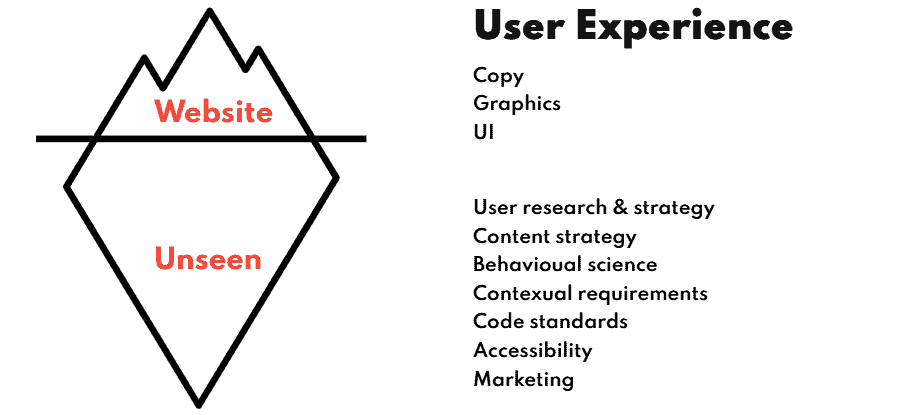Reasons to become an agile web designer. # 1 Better work
This is the first of 5 posts on how web designers could benefit from adopting an agile mindset.
This one, on better work quality and opportunities, will be a little bit longer as I need to offer some historical context.
Traditional Vs Agile approaches
Most will be familiar with Traditional web projects. They start with a brief from the client which turns into a proposal from the designer on what can be delivered by a set time.
There’s an agreement that sets the scope of the project and what each party is responsible for. The website is sold as a commodity.
Many in WordPress use a car analogy. When the site comes off the production line the “keys” are handed over to the owner, but they are advised to take a maintenance plan to keep it running well.
Agile projects are about collaborating with clients to deliver a product via iterative testing. The end deliverable is not fixed in advance and responsibilities are not divided into “us and them”.
It was a reaction to the digital revolution and the failure of traditional project management to respond to change and make use of the real time feedback the internet offers.
Early adoption is most associated with the meteoric rise of the trillion dollar “Big Tech” companies, but now agile is the primary approach for software and IT related projects.
Perhaps more significantly, it has gone far beyond its roots in technology. Increasingly companies, including Government bodies, are seeing it as the sensible way to do business in a changed world.
Why do web designers appear to be swimming against the tide?
In the early days of the web most businesses only needed to get their static brochure sites online. Web designers were hired because they had the HTML and CSS skills to make that happen.
With agile methodologies mostly unknown it made sense to sell these custom coded sites as commodities. Web design influencers of the time came up with the production line type process to do that.
It had a problem though. Clients had to be a part of that process and rather inconveniently these bill paying humans were not as passive as car parts on an assembly line. Web designers were finding themselves out of pocket.
The “solution” came in the next wave of influencers. They had expertise in sales and figured we could “value price” the commodity.
Keep the same traditional project management, but promise the end product would give the buyer a greater return. It would be less of a disaster if the client threw a spanner in the works. Low budget clients should be avoided.
The rise of site builders
By the time this second wave of influencers appeared most designers had moved to CMSs like WordPress to meet the client demands to be able to update their own content and have it displayed dynamically.
Most no longer delivered commodities entirely of their own making, but ones that depended on third parties.
Some like to refer to this software and their website building tools. Something clients don’t need to be concerned with, but it’s a poor analogy as skilled craft people take their tools home with them.
In reality, this was a significant shift. Web designers were effectively partnering with software businesses and outsourcing the new requirement for technical agility.
Still, as long as clients took up a maintenance plan and the software vendor was reliable, the web designers could continue with their traditional approach.
As an aside, when I moved to (the sponsor of the blog) Beaver Builder in 2014 I realised my level of dependency was significantly high with page builders. I rarely questioned this in my previous 7 years with WordPress as I was mostly building sites manually on top of what was a relatively unchanging CMS.
Because of this I started my relationship with Beaver Builder seeing them as my silent business partner. Their values and commitment to serving agencies like mine were as important to me (if not more so) than the features of their platform.
I suspect this thinking was due to first becoming aware of the Agile movement the year before when the Gov.uk website became the first (and only) website to win the design of the year award.
Outside of WordPress circles this did much to promote the Agile mindset among web designers. I mean… the UK government, of all people, not setting hard deadlines and project scope – whatever next?!
Are we sitting ducks?
Advanced page builders can allow us to speed up our work, give clients a helpful UI for their content update and do more without knowing a programming language.
But the big money for page builders is in serving the public directly. Even the once simple WordPress CMS is now, with Gutenberg, becoming a complex page builder, seeking to make website building easy for all.
The commodity we sold – a beautifully designed website – can now be obtained with the click of a button for free. No coding is needed to adapt it to the owner’s needs.
Of course, many will still want to hire someone, but the propositions web designers put forward are based on promises that now anyone can claim to deliver with the right software.
It’s not easy to tell an experienced web designer from someone who buys software.
The one who gets the work is likely to be the best sales person. The one who gets paid for it (even if the client is unhappy) is the one with the tightest contract.
It’s open to fly-by-night businesses which leads to further distrust of our industry and more DIY building in house.
Websites as front of house staff
The need to respond to technological change was not the only driving force behind the move to agile approaches.
Growing at the same time was the realisation that websites were becoming the initial and primary way companies communicate and engage with their customers.
We’re in an age where we might Google the businesses we are only inches away from rather than walk through the door.
If we start to see websites as essential front of house staff we quickly see they are never “done”. They are not commodities to be “launched” .
Like real staff, they have to keep learning and responding to the changes in interactions and environment. Like staff they help companies to evolve.
I’m not suggesting small web agencies can adopt Amazon’s “continuous delivery” approach by pushing out tests every 11.6 seconds.
But, I think anyone who has been in web design for any length of time knows that traffic and conversions come from ongoing SEO and UX processes and strategies that require us to follow the data rather than assume. They require agility.
Even if unwittingly learned, experienced web designers have been assimilating the basics of UX for many years.
They instinctively know the website itself is just the visible tip of the much larger UX iceberg. What makes an effective design is the groundwork that understands and responds to the user’s changing motivations and needs.
It is what distinguishes good web designers from site builders.
It is why templated solutions and page builder software will not remove the need for web designers, but I think we need to distinguish ourselves by our practices not promises.
- Adopting an agile approach allows us to work together with clients to achieve observable results through testing.
- An agile approach allows clients to experience and be involved in bringing the essential “soft skills” that are required in good design.
- Agile approaches help build better sites by setting truthful expectations about how users interact with them. This helps clients to invest in following on from what was done rather than undoing earlier work.
Agile is the thing you are
Those wedded to traditional approaches are always going to claim they accommodate the agility a website requires and that will often be true. They will add.
- SEO as an addon service.
- Maintenance plans will include time for design updates.
- Discovery sessions can help them understand what the users may need as a form of basic UX.
In my view, this is paying lip service. Being Agile is a mindset.
If you start with this philosophy (not a specific agile methodology) you have the agility to scale that up or down according to clients needs and returns.
But if you start with restrictions on projects, spend the allocated budget on a guesswork and start with an us and them relationship it’s not going to be easy to turn that around.
The Agile movement has snowballed greatly over the last few years. Even as late as 2017 the U.S government lost around $32 billion in one year with failed IT projects before changing its approach.
I believe more companies with decent budgets for web design will be less willing to accept traditional project management for anything less than a clearly understood product or service.
I don’t see the expectations from websites moving in a backward direction in the near future.






